Why Should We Test the Wideband Transformation Accuracy of Medium Voltage Inductive Voltage Transformers?
Abstract
:1. Introduction
2. Defined Accuracy Requirements for Transformation of Higher Harmonics in the Group of the Standards IEC 61869
3. The Object of the Research and the Equivalent Circuit of Inductive VT for WIDEBAND Operation up to 20 kHz
4. Measuring System and Tests Conditions
5. The Results of the Measurements for Transformation of Harmonics of the Distorted Primary Voltage
6. Conclusions
Author Contributions
Funding
Institutional Review Board Statement
Informed Consent Statement
Data Availability Statement
Conflicts of Interest
List of Symbols and Acronyms
| C”B12/C”B(n-1)n | parasitic capacitance between neighbor layers of the primary winding, |
| C”G11/C”G12/C”G1n | partial equivalent capacitance of the primary winding to ground, |
| C”T11/C”T12/C”T1n | partial equivalent capacitance between the primary and secondary windings, |
| C2 | equivalent capacitance of the secondary winding, |
| DA | high impedance wideband amplifier (1:1) to convert the differential voltage to single ended voltage, |
| DPM | digital power meter, |
| hk | order of higher harmonic e.g., h1 is first harmonic, h3 is third harmonic. |
| L’’μ | mutual inductance between primary and secondary windings, |
| L”11/L”12/L”1n | partial leakage inductance of the primary winding, |
| L2 | leakage inductance of the secondary winding, |
| MAX(ϕUTVThk) | the maximum value of phase displacement, |
| MAX(ΔUTVThk) | the maximum value of voltage error, |
| PPS | programmable power supply system, |
| R”11/R”12/R”1n | partial resistance of the primary winding, |
| R”Fe | equivalent resistance of the iron losses in the magnetic core, |
| R2 | resistance of the secondary winding, |
| RVD | reference wideband voltage divider, |
| SVT | supplying inductive VT used to step-up distorted voltage, |
| TVT | tested inductive voltage transformer, |
| U(C)TVThk | the RMS values of a hk harmonic in the output voltage of the TVT; (UCVThk) if differential method is used or measured by DPM on the secondary winding of TVT (UTVThk), |
| u”1 | instantaneous value of the primary voltage, |
| u2 | instantaneous value of the secondary voltage, |
| UCVThk | calculated RMS value of a hk harmonic on the secondary winding of TVT, |
| UDAhk | the RMS values of a hk higher harmonic in the output voltage of the DA, |
| Ughk% | the the percentage values of the self-generated higher harmonics into the secondary voltage |
| URVDhk | the RMS values of a hk harmonic in the output voltage of the RVD, |
| ΔUTVT[MAX(ϕUTVThk)] | the value of voltage error determined for the MAX(ϕUTVThk), |
| ΔεTVThk | the value of the composite error of transformation of a hk harmonic of the distorted voltage by TVT, |
| ζ(ϕUTVThk) | the average value of the change of the phase displacement with phase angle of transformed higher harmonic in relation to the main higher harmonic of distorted voltage, |
| ζ(ΔUTVThk) | the average value of the change of the voltage error with phase angle of transformed higher harmonic in relation to the main higher harmonic of distorted voltage, |
| φUTVThk | the phase displacement of transformation of a hk harmonic of the distorted voltage by TVT, |
| ϕRVDDAhk | the phase shift of a hk harmonic in the output voltage of the DA in relation to the hk harmonic in the reference voltage from the RVD, |
| ϕUTVT[MAX(ΔUTVThk)] | the value of phase displacement determined for the MAX(ΔUTVThk). |
References
- IEC. IEC 61869-103 Instrument Transformers—The Use of Instrument Transformers for Power Quality Measurement; IEC: Geneva, Switzerland, 2012. [Google Scholar]
- Vieira, D.; Shayani, R.A.; De Oliveira, M.A.G. Reactive Power Billing under Nonsinusoidal Conditions for Low-Voltage Systems. IEEE Trans. Instrum. Meas. 2017, 66, 2004–2011. [Google Scholar] [CrossRef]
- Kaczmarek, M. Measurement error of non-sinusoidal electrical power and energy caused by instrument transformers. IET Gener. Transm. Distrib. 2016, 10, 3492–3498. [Google Scholar] [CrossRef]
- Faifer, M.; Laurano, C.; Ottoboni, R.; Toscani, S.; Zanoni, M. Harmonic Distortion Compensation in Voltage Transformers for Improved Power Quality Measurements. IEEE Trans. Instrum. Meas. 2019, 68, 3823–3830. [Google Scholar] [CrossRef]
- Kaczmarek, M. Inductive current transformer accuracy of transformation for the PQ measurements. Electr. Power Syst. Res. 2017, 150, 169–176. [Google Scholar] [CrossRef]
- Filipović-Grčić, D.; Filipović-Grčić, B.; Krajtner, D. Frequency response and harmonic distortion testing of inductive voltage transformer used for power quality measurements. Procedia Eng. 2017, 202, 159–167. [Google Scholar] [CrossRef]
- Kaczmarek, M.; Stano, E. Nonlinearity of Magnetic Core in Evaluation of Current and Phase Errors of Transformation of Higher Harmonics of Distorted Current by Inductive Current Transformers. IEEE Access 2020, 8, 118885–118898. [Google Scholar] [CrossRef]
- Kaczmarek, M.; Stano, E. Measuring system for testing the transformation accuracy of harmonics of distorted voltage by medium voltage instrument transformers. Measurement 2021, 181, 109628. [Google Scholar] [CrossRef]
- Kaczmarek, M.; Brodecki, D. Transformation of Transient Overvoltages by Inductive Voltage Transformers. Sensors 2021, 21, 4167. [Google Scholar] [CrossRef]
- Popov, M. General approach for accurate resonance analysis in transformer windings. Electr. Power Syst. Res. 2018, 161, 45–51. [Google Scholar] [CrossRef]
- Aydogan, A.; Atalar, F.; Yilmaz, A.E.; Rozga, P. Using the method of harmonic distortion analysis in partial discharge assessment in mineral oil in a non-uniform electric field. Energies 2020, 13, 4830. [Google Scholar] [CrossRef]
- Mingotti, A.; Bartolomei, L.; Peretto, L.; Tinarelli, R. On the long-period accuracy behavior of inductive and low-power instrument transformers. Sensors 2020, 20, 5810. [Google Scholar] [CrossRef] [PubMed]
- Crotti, G.; D’Avanzo, G.; Giordano, D.; Letizia, P.S.; Luiso, M. Extended SINDICOMP: Characterizing MV Voltage Transformers with Sine Waves. Energies 2021, 14, 1715. [Google Scholar] [CrossRef]
- Faifer, M.; Laurano, C.; Ottoboni, R.; Toscani, S.; Zanoni, M.; Crotti, G.; Giordano, D.; Barbieri, L.; Gondola, M.; Mazza, P. Overcoming Frequency Response Measurements of Voltage Transformers: An Approach Based on Quasi-Sinusoidal Volterra Models. IEEE Trans. Instrum. Meas. 2019, 68, 2800–2807. [Google Scholar] [CrossRef]
- IEC. IEC 61869-6 Instrument Transformers—Additional General Requirements for Low-Power Instrument Transformers; IEC: Geneva, Switzerland, 2016. [Google Scholar]
- Stano, E.; Kaczmarek, M. Wideband self-calibration method of inductive cts and verification of determined values of current and phase errors at harmonics for transformation of distorted current. Sensors 2020, 20, 2167. [Google Scholar] [CrossRef] [PubMed] [Green Version]
- Ballal, M.S.; Wath, M.G.; Suryawanshi, H.M. A novel approach for the error correction of ct in the presence of harmonic distortion. IEEE Trans. Instrum. Meas. 2019, 68, 4015–4027. [Google Scholar] [CrossRef]
- Cristaldi, L.; Faifer, M.; Laurano, C.; Ottoboni, R.; Toscani, S.; Zanoni, M. A Low-Cost Generator for Testing and Calibrating Current Transformers. IEEE Trans. Instrum. Meas. 2019, 68, 2792–2799. [Google Scholar] [CrossRef]
- Kaczmarek, M.; Stano, E. Proposal for extension of routine tests of the inductive current transformers to evaluation of transformation accuracy of higher harmonics. Int. J. Electr. Power Energy Syst. 2019, 113, 842–849. [Google Scholar] [CrossRef]
- Klatt, M.; Meyer, J.; Elst, M.; Schegner, P. Frequency responses of MV voltage transformers in the range of 50 Hz to 10 kHz. In Proceedings of the ICHQP 2010—14th International Conference on Harmonics and Quality of Power, Bergamo, Italy, 26–29 September 2010; pp. 1–6. [Google Scholar]
- Lesniewska, E.; Kaczmarek, M.; Stano, E. 3D Electromagnetic Field Analysis Applied to Evaluate the Accuracy of a Voltage Transformer under Distorted Voltage. Energies 2021, 14, 136. [Google Scholar] [CrossRef]
- IEC. IEC 61869-3 Instrument Transformers—Additional Requirements for Inductive Voltage Transformers; IEC: Geneva, Switzerland, 2011. [Google Scholar]
- IEC. IEC 61869-11 Instrument Transformers—Additional Requirements for Low Power Passive Voltage Transformers; IEC: Geneva, Switzerland, 2017. [Google Scholar]
- Kaczmarek, M. The effect of distorted input voltage harmonics rms values on the frequency characteristics of ratio error and phase displacement of a wideband voltage divider. Electr. Power Syst. Res. 2019, 167, 1–8. [Google Scholar] [CrossRef]
- Kaczmarek, M.; Szatilo, T. Reference voltage divider designed to operate with oscilloscope to enable determination of ratio error and phase displacement frequency characteristics of MV voltage transformers. Meas. J. Int. Meas. Confed. 2015, 68, 22–31. [Google Scholar] [CrossRef]
- Kaczmarek, M. Development and application of the differential voltage to single-ended voltage converter to determine the composite error of voltage transformers and dividers for transformation of sinusoidal and distorted voltages. Meas. J. Int. Meas. Confed. 2017, 101, 53–61. [Google Scholar] [CrossRef]
- Kaczmarek, M.; Kaczmarek, P. Comparison of the wideband power sources used to supply step-up current transformers for generation of distorted currents. Energies 2020, 13, 1849. [Google Scholar] [CrossRef]
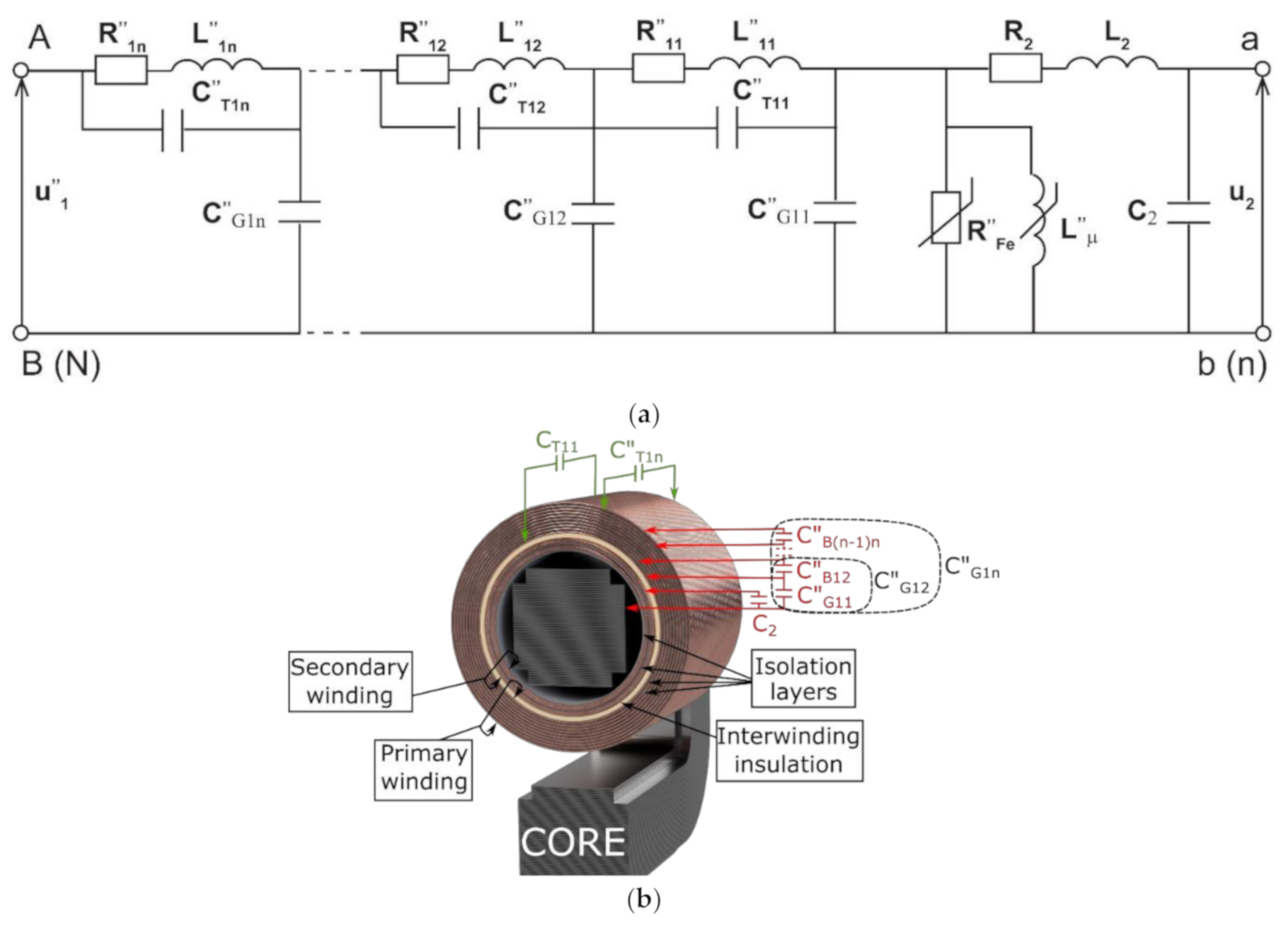
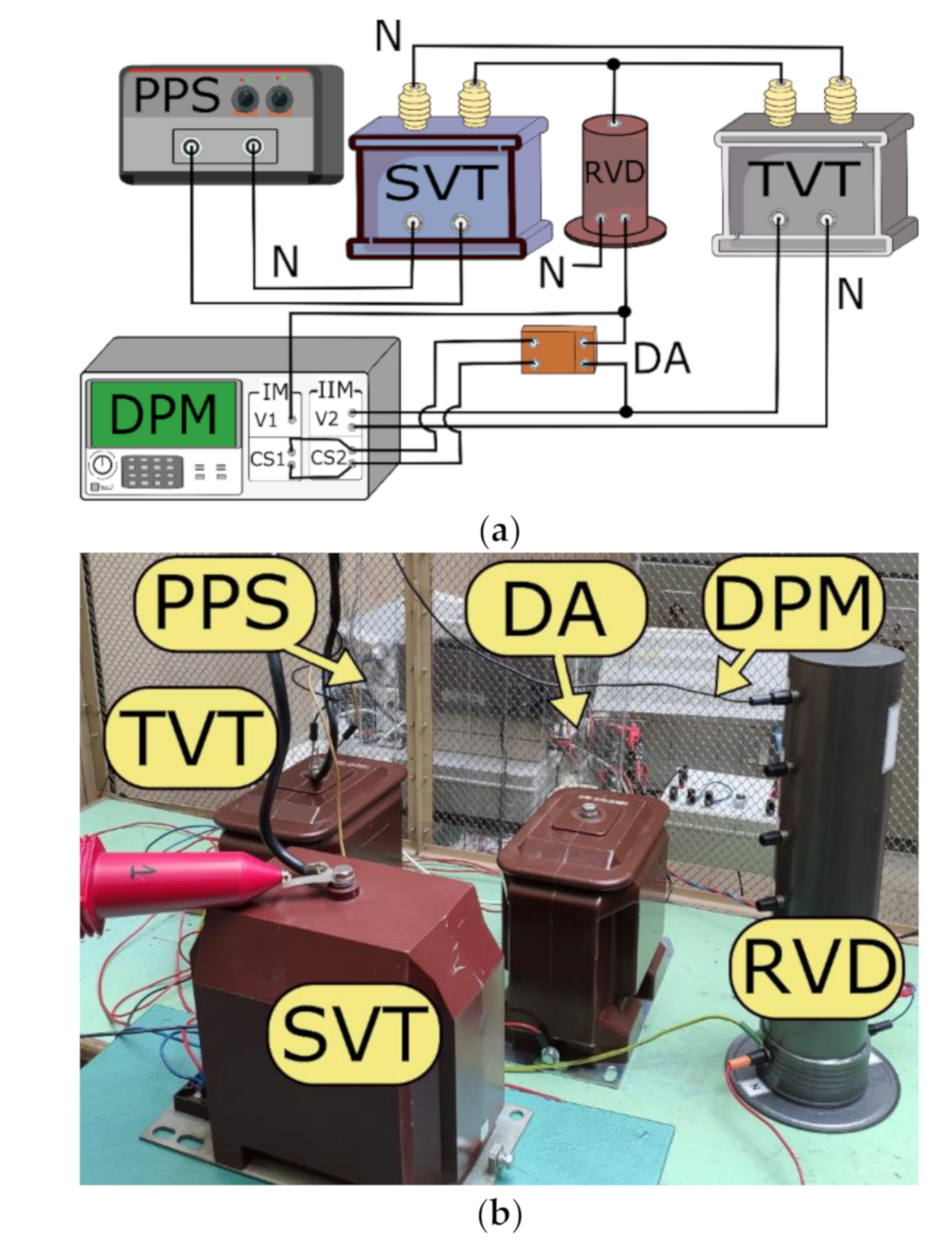
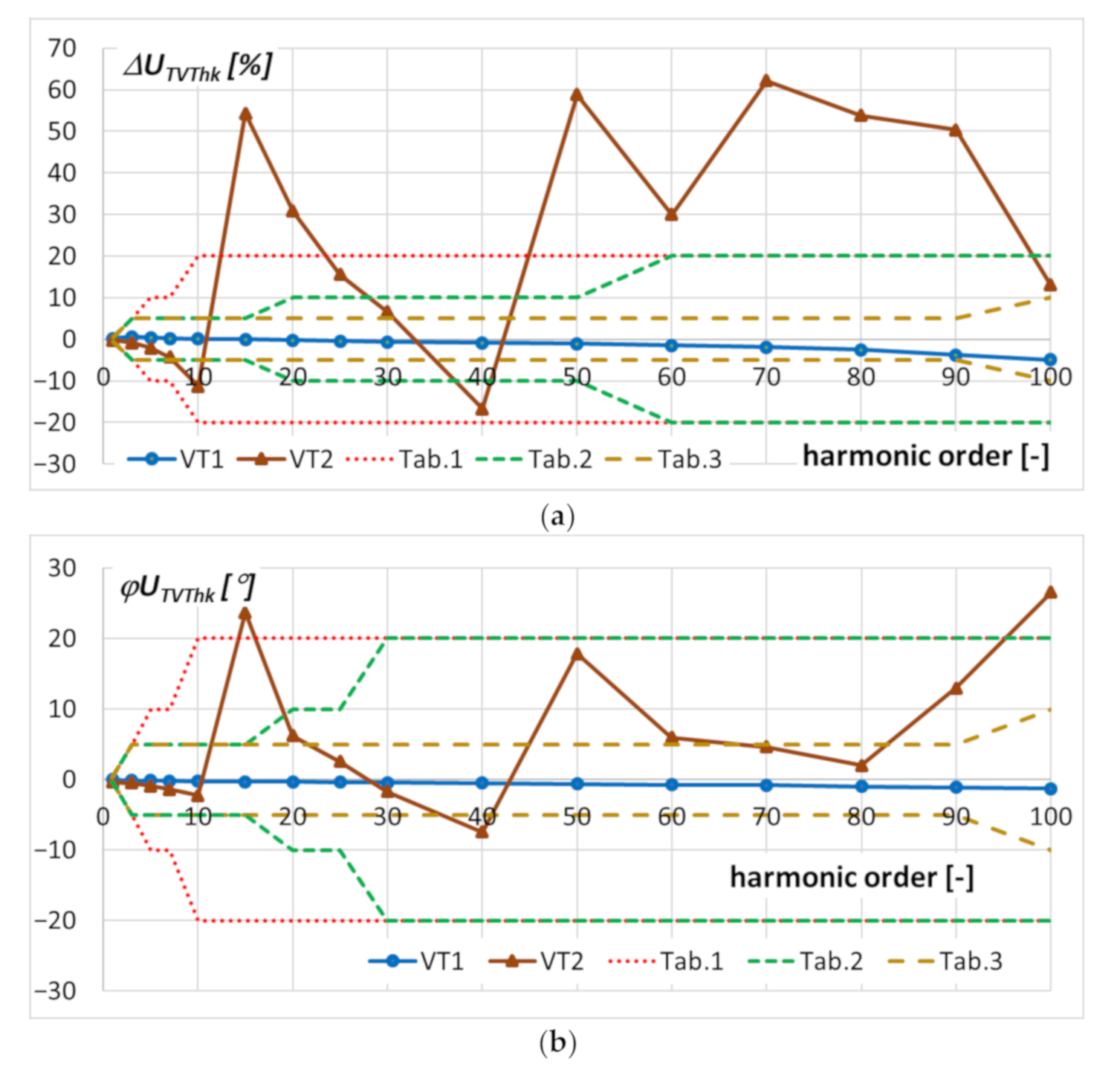
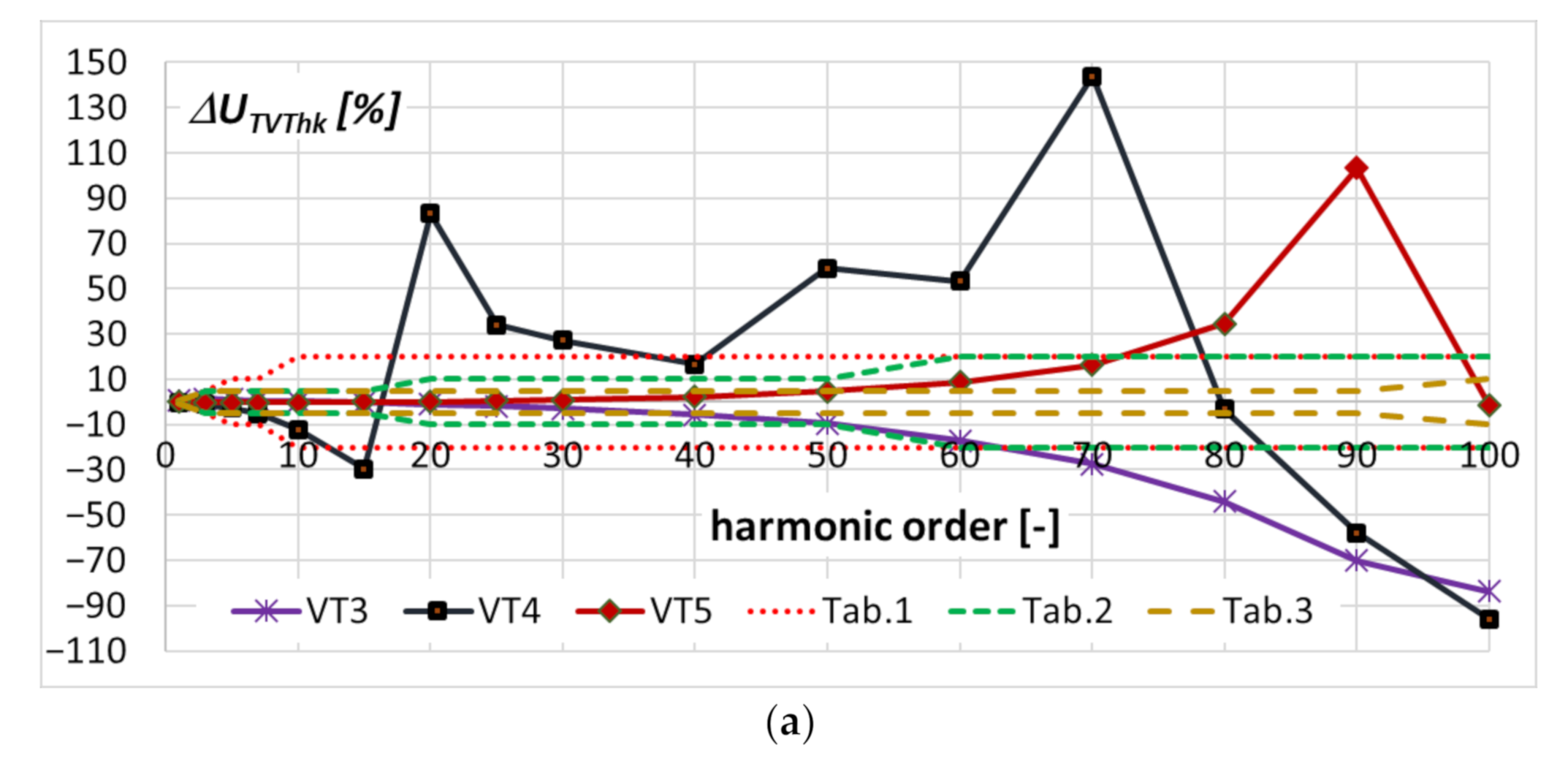
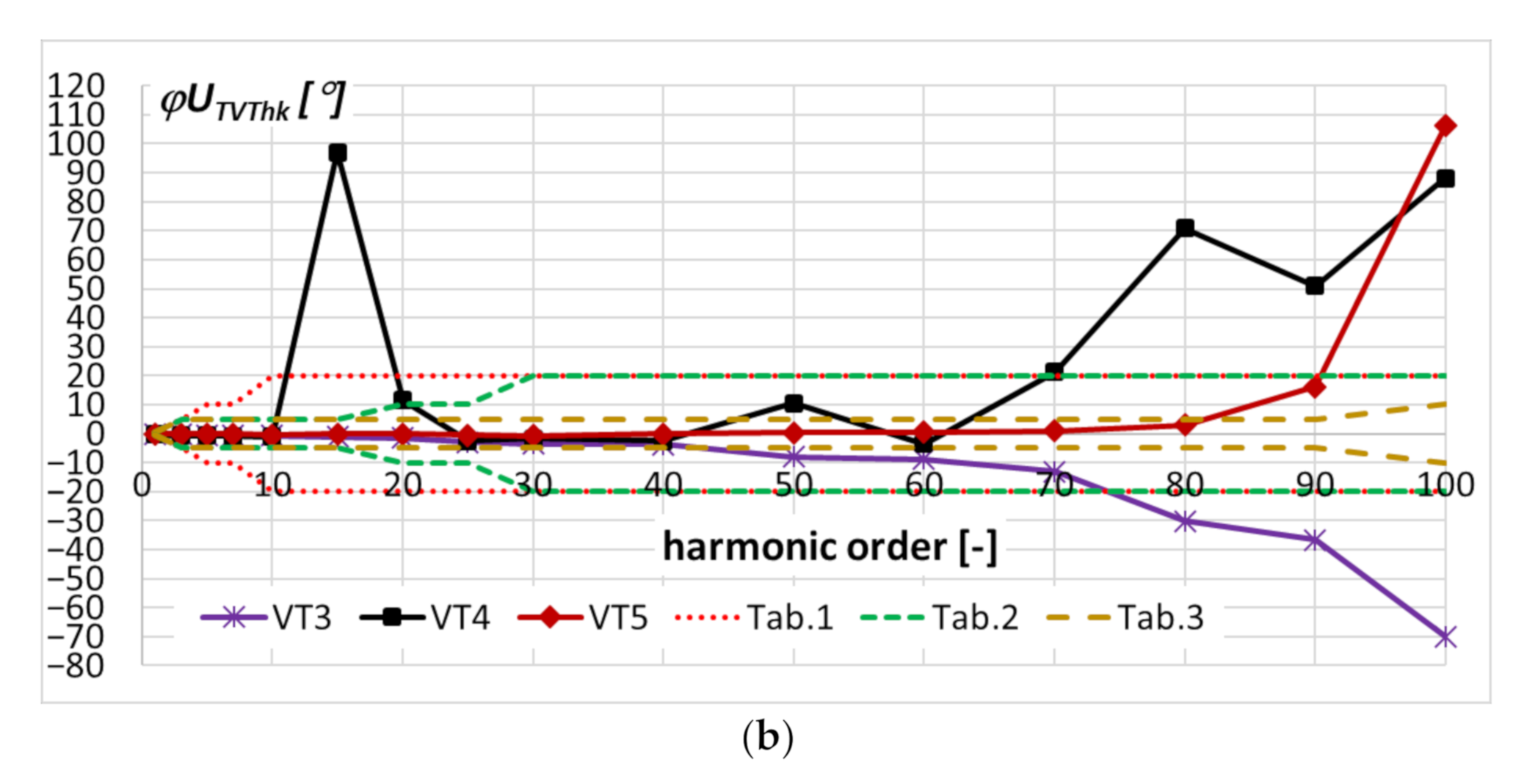
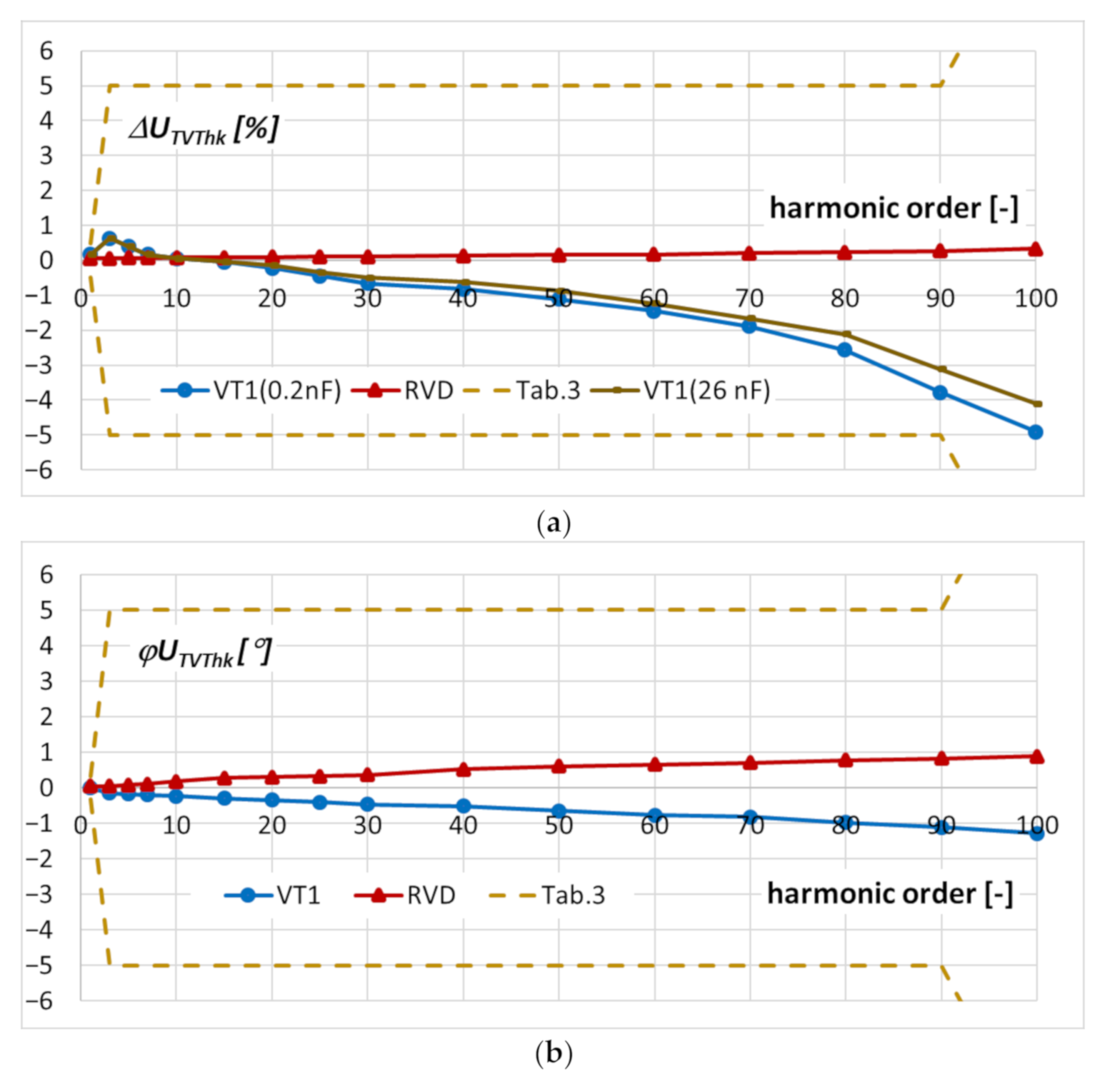
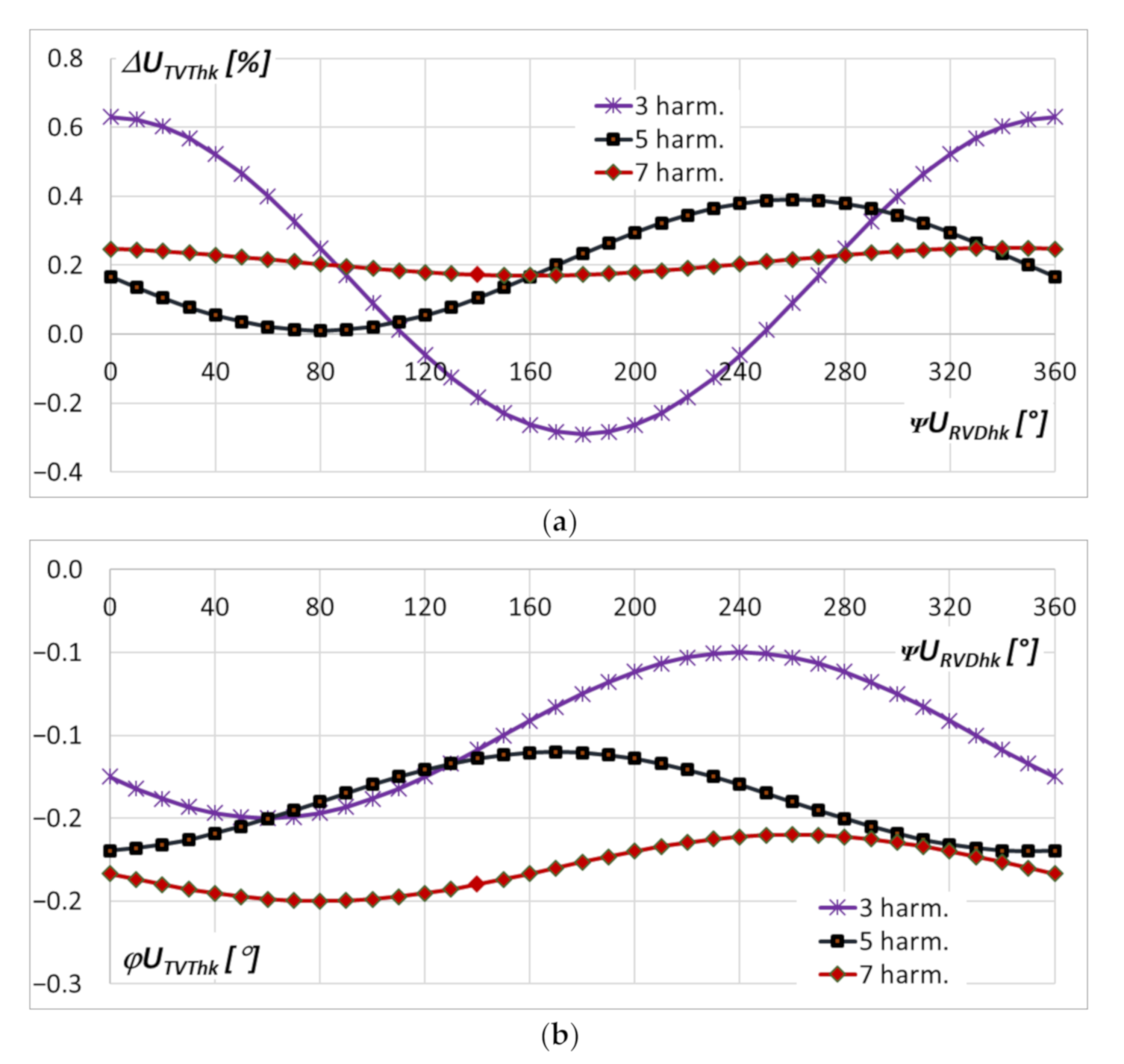
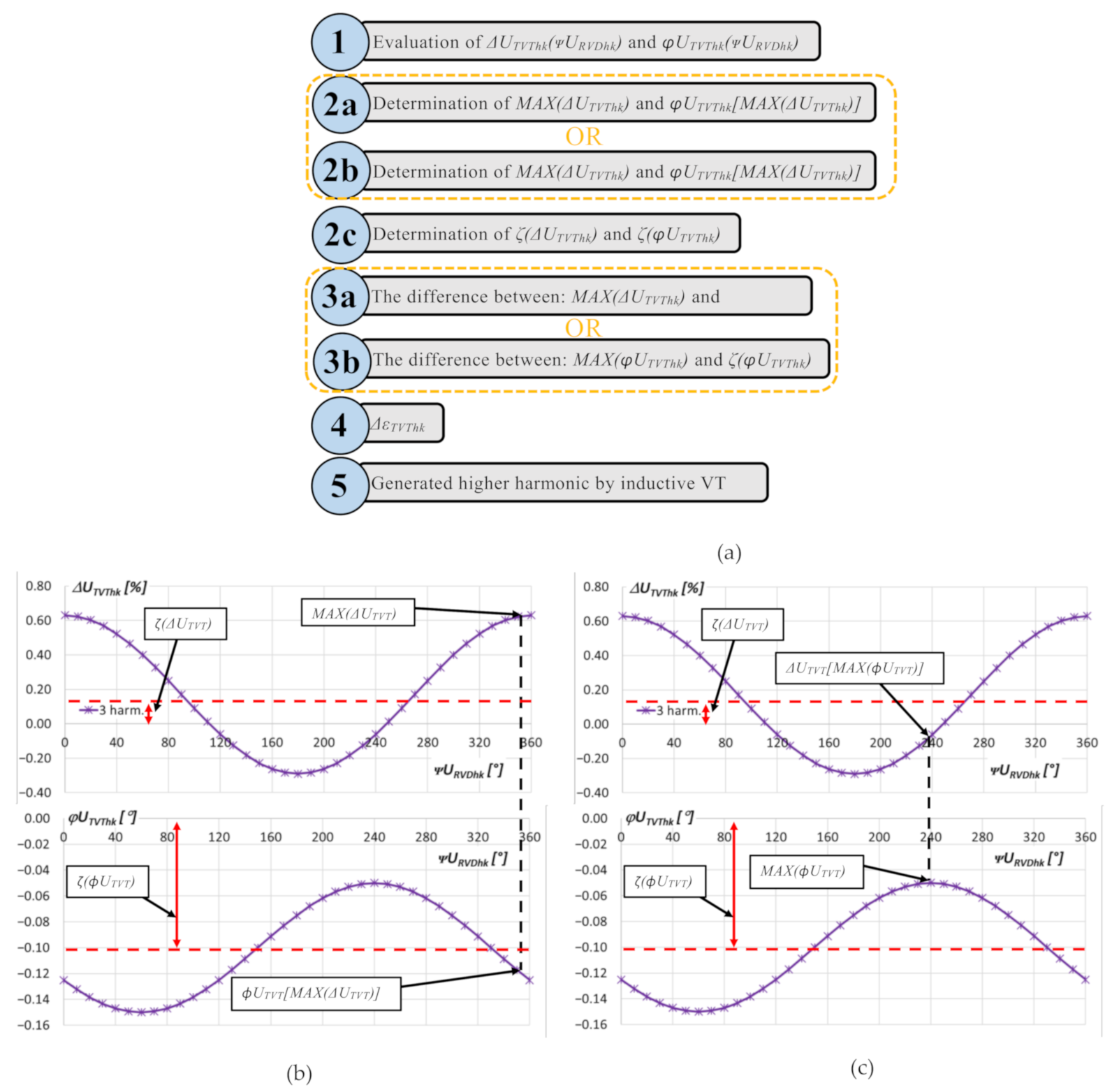

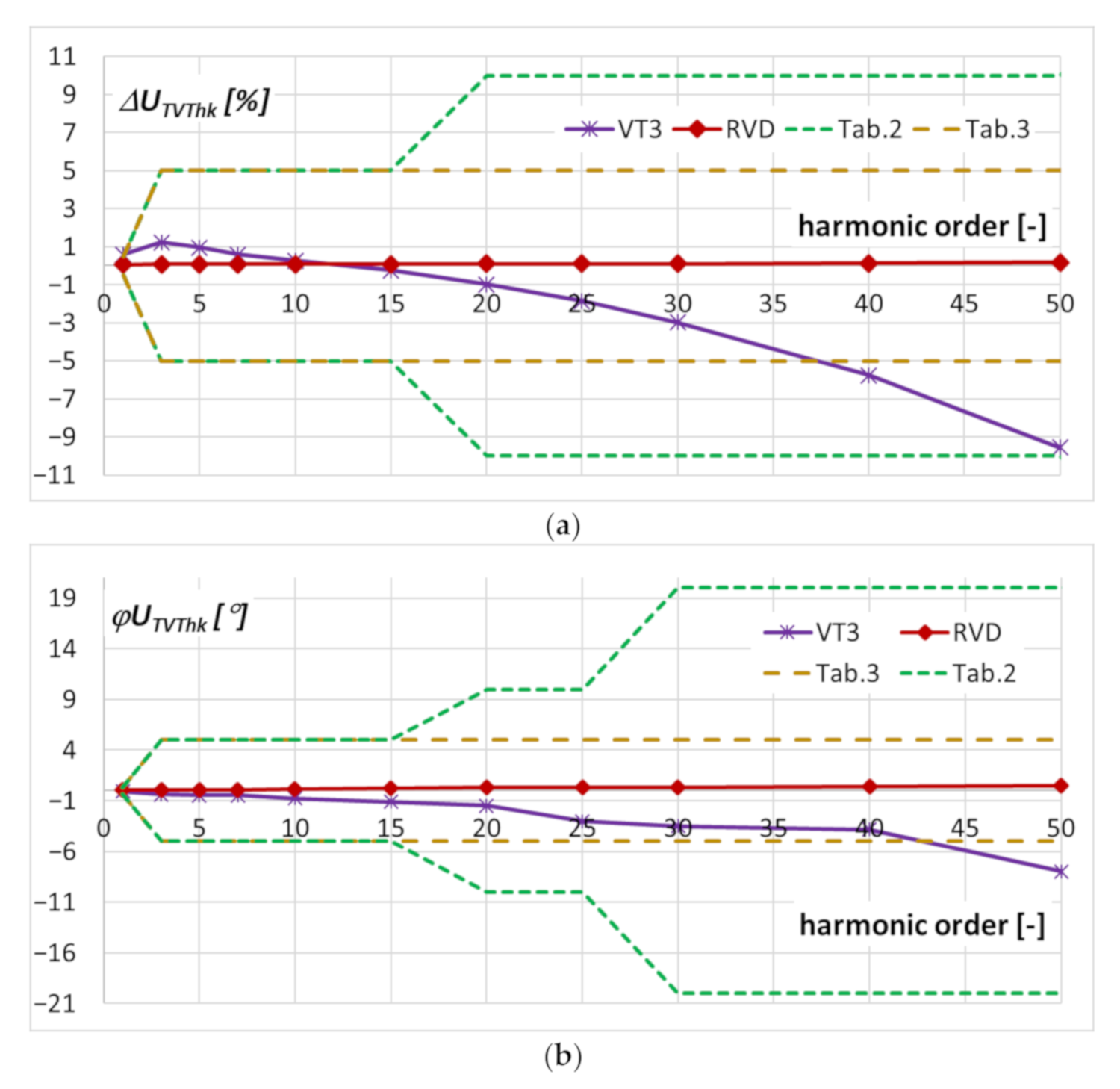
| Accuracy Class | Ratio Error at Low Frequency [%] | Ratio Error (±) at Harmonics [%] | Phase Displacement (±) at Low Frequency [°] | Phase Displacement (±) at Harmonics [°] | ||||||||
|---|---|---|---|---|---|---|---|---|---|---|---|---|
| 0 Hz | 1 Hz | 2nd to 4th | 5th and 6th | 7th to 9th | 10th to 13th | Above 13th | 1 Hz | 2nd to 4th | 5th and 6th | 7th to 9th | 10th to 13th | |
| 0.1 | +1 −100 | +1 −30 | 1 | 2 | 4 | 8 | +8 −100 | 45 | 1 | 2 | 4 | 8 |
| 0.2 0.2S | +2 −100 | +2 −30 | 2 | 4 | 8 | 16 | +16 −100 | 45 | 2 | 4 | 8 | 16 |
| 0.5 0.5S | +5 −100 | +5 −30 | 5 | 10 | 20 | 20 | +20 −100 | 45 | 5 | 10 | 20 | 20 |
| 1 | +10 −100 | +10 −30 | 10 | 20 | 20 | 20 | +20 −100 | 45 | 10 | 20 | 20 | 20 |
| Accuracy Class | Ratio Error (±) at Frequencies Shown Below [%] | Phase Displacement (±) at Frequencies Shown Below [°] | ||||
|---|---|---|---|---|---|---|
| (0.1 ≤ f ˂ 1) kHz | (1 ≤ f ˂ 1.5) kHz | (1.5 ≤ f ˂ 3) kHz | (0.1 ≤ f ˂ 1) kHz | (1 ≤ f ˂ 1.5) kHz | (1.5 ≤ f ˂ 3) kHz | |
| 0.1 | 1 | 2 | 5 | 1 | 2 | 5 |
| 0.2 0.2S | 2 | 4 | 5 | 2 | 4 | 5 |
| 0.5 0.5S | 5 | 10 | 10 | 5 | 10 | 20 |
| 1 | 10 | 20 | 20 | 10 | 20 | 20 |
| Accuracy Class | Ratio Error (±) at Frequencies Shown Below [%] | Phase Displacement (±) at Frequencies Shown Below [°] | ||||
|---|---|---|---|---|---|---|
| (0.1 ≤ f ˂ 5) kHz | (5 ≤ f ˂ 10) kHz | (10 ≤ f ˂ 20) kHz | (0.1 ≤ f ˂ 5) kHz | (5 ≤ f ˂ 10) kHz | (10 ≤ f ˂ 20) kHz | |
| 0.1 | 1 | 2 | 5 | 1 | 2 | 5 |
| 0.2 0.2S | 2 | 4 | 5 | 2 | 4 | 5 |
| 0.5 0.5S | 5 | 10 | 10 | 5 | 10 | 20 |
| 1 | 10 | 20 | 20 | 10 | 20 | 20 |
| TVT | Rated Primary Voltage [kV] | Ratio Error at Rated Frequency 50 Hz [%] | Phase Displacement at Rated Frequency 50 Hz [°] |
|---|---|---|---|
| VT1 | 15/√3 | +0.17 | +0.03 |
| VT2 | −0.21 | −0.39 | |
| RVD | +0.04 | +0.03 | |
| VT3 | 20/√3 | −0.11 | −0.34 |
| VT4 | −0.31 | −0.36 | |
| VT5 | −0.03 | +0.03 | |
| RVD | +0.04 | +0.04 |
Publisher’s Note: MDPI stays neutral with regard to jurisdictional claims in published maps and institutional affiliations. |
© 2021 by the authors. Licensee MDPI, Basel, Switzerland. This article is an open access article distributed under the terms and conditions of the Creative Commons Attribution (CC BY) license (https://creativecommons.org/licenses/by/4.0/).
Share and Cite
Kaczmarek, M.; Stano, E. Why Should We Test the Wideband Transformation Accuracy of Medium Voltage Inductive Voltage Transformers? Energies 2021, 14, 4432. https://doi.org/10.3390/en14154432
Kaczmarek M, Stano E. Why Should We Test the Wideband Transformation Accuracy of Medium Voltage Inductive Voltage Transformers? Energies. 2021; 14(15):4432. https://doi.org/10.3390/en14154432
Chicago/Turabian StyleKaczmarek, Michal, and Ernest Stano. 2021. "Why Should We Test the Wideband Transformation Accuracy of Medium Voltage Inductive Voltage Transformers?" Energies 14, no. 15: 4432. https://doi.org/10.3390/en14154432
APA StyleKaczmarek, M., & Stano, E. (2021). Why Should We Test the Wideband Transformation Accuracy of Medium Voltage Inductive Voltage Transformers? Energies, 14(15), 4432. https://doi.org/10.3390/en14154432








